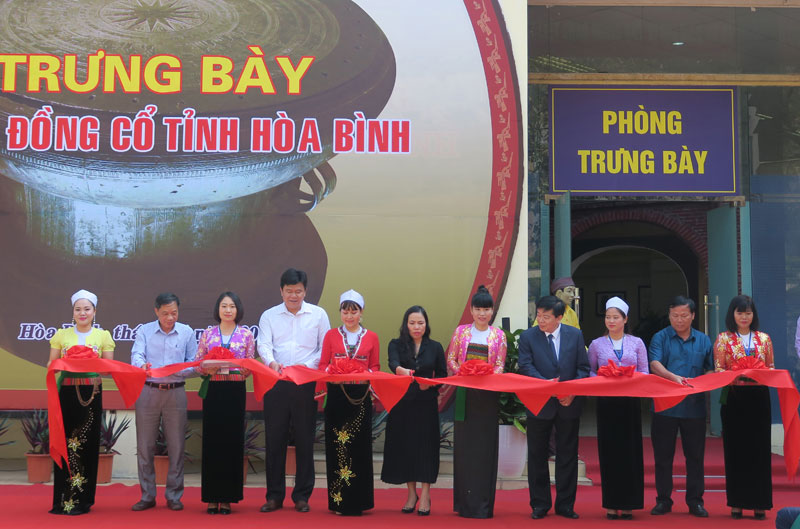
(HBO) – The Hoa Binh Department of Culture, Sports and Tourism recently launched an exhibition on antique bronze drums found in the province. The opening ceremony was attended by Vice Chairman of the provincial People’s Committee Nguyen Van Chuong along with representatives from some departments and sectors, and over 100 students across Hoa Binh city.
 Nguyen
Van Chuong, Vice Chairman of the provincial People’s Committee and other
delegates cut the ribbon to kick off the exhibition.
Nguyen
Van Chuong, Vice Chairman of the provincial People’s Committee and other
delegates cut the ribbon to kick off the exhibition.
Bronze drums are treasures left by ancestors since
the nation’s foundation. The Dong Son culture dated back to the first century
BC was seen as the most brilliant period of development of bronze drums in
Vietnam. So far over 1,000 bronze drums have been found, mainly in northern
provinces.
In Hoa Binh alone, the cradle of Hoa Binh
culture, more than 100 ancient bronze drums of all kinds have been uncovered,
ranking second nationwide in the number, after the north central province of
Thanh Hoa.
Ancient bronze drums in Hoa Binh are mainly of
the Heger II type (over 90 percent). They are dated from the first century to
the 17th century.
The drums were discovered in almost all
districts in the province. Apart from some drums found in ancient Muong tombs,
the remainder was mainly uncovered by chance when locals dug ditches or built houses
and roads.
On display at the provincial museum were nearly
200 documents and objects featuring the origin and values of ancient bronze
drums.
The exhibition is one of the activities to
welcome the Hoa Binh culture-tourism week 2019 with the aim of introducing the
local bronze drums and unique culture of ethnic groups in the province./.
The People’s Committee of Lac Son district held a ceremony on April 28 to receive the provincial relic certificate for the ancient rock carving site at Suoi Co stream, located in My Thanh commune.
A special music show titled "The country is in the fullness of joy” has been held at Hoa Binh Square in Hoa Binh city in celebration of the 50th anniversary of the liberation of the South and national reunification (April 30, 1975–2025).
The People's Committee of Lo Son commune, Tan Lac district, has organised the local annual traditional stream fishing festival on April 19 - 20.
As a land deeply intertwined with human history and Vietnam’s millennia-long journey of nation-building and defence, Hoa Binh is often revered for its epic tales and legends.
Residents of Hoa Binh boast a rich cultural identity, reflected in their unique language, traditional attire, customs, and folk melodies – described as "sweet as honey, clear as a mountain stream.”
Lac Son district’s Vu ban town held the 2025 Truong Kha temple festival on April 12–13 (the 15th–16th days of the third lunar month). Since its revival in 2019, the festival has been organised every three years, preserving valuable intangible heritage while meeting the community’s cultural and spiritual needs.



 Nguyen
Van Chuong, Vice Chairman of the provincial People’s Committee and other
delegates cut the ribbon to kick off the exhibition.
Nguyen
Van Chuong, Vice Chairman of the provincial People’s Committee and other
delegates cut the ribbon to kick off the exhibition.